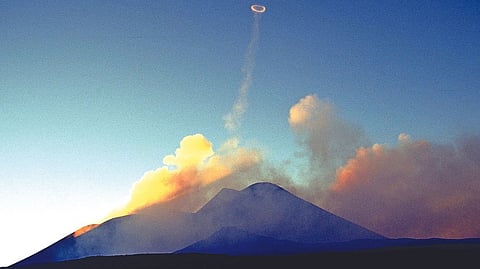

By Carolyn Wilke
NEW YORK: Some volcanoes perform a rather subtle trick: blowing rings of vapour that waft near their craters.
The short-lived rings have been observed occasionally at volcanoes like Etna in Italy and Eyjafjallajökull in Iceland.
Now researchers have found new clues about how bursting gas bubbles create these curiosities in some volcanoes.
Most volcano research focuses on the strong eruptions that threaten human lives, said Simona Scollo, a volcanologist at the National Institute of Geophysics and Volcanology in Italy.
But “we want to understand how our volcanoes work,” she said, “not only when they create a disaster for people or when they are very dangerous.” So she and her team investigated the rings, which are typically associated with relatively mild volcanic activity.
They published their findings last month in the journal Scientific Reports.
There are similarities between how volcanoes huff out these halos and how dolphins blow bubble rings or how smokers exhale smoke rings.
And the volcanic versions are commonly called smoke rings, although they’re actually made mostly of water vapour.
Researchers usually say “vapour rings” or “vortex rings” when describing the whorl of a ring’s gas. Emissions exiting a volcano’s blowhole (or a smoker’s mouth) slow down where they encounter a surface, causing the gas to loop over on itself.
But it’s not exactly clear what is happening within a volcano that leads to a vapour ring. Even volcanoes known for such puffery don’t make rings all the time.
Dr. Scollo’s team scoured the internet and research footage for vapour rings caught on camera. The rings they found were 30 to 650 feet in diameter and lasted up to 10 minutes. Typically white, vapour rings were occasionally tinged with gray or brown from ash.
The researchers modelled the possible motion of gas and bubbles within the barrel of a volcano.
For vapour rings to form, small gas bubbles had to merge and float up through the magma to create pressurized gas pockets.
When such pockets explode, they could push out some gas fast enough to make a vapour ring.
But the volcano’s opening also needed to be circular or slightly smushed. Volcanoes with irregular or more elliptical openings didn’t typically form rings. When they did, these apertures warped the doughnut shape or caused the ring to wobble, the team reported.
Combining the photo and video observations with the model allowed the team to find physical conditions needed to make vapour rings.
“Once we understand that then we can understand something about the volcano itself,” said David Fee, a volcanologist at the University of Alaska Fairbanks who was not part of the work.
As an example, ring emissions may say something about a volcano’s magma. Volcanoes that release hoops of vapour have liquid rock that is more likely to flow.
But, Dr. Fee cautioned, there are limits to what vapour rings can reveal about volcanoes.
For instance, when a volcano becomes dangerous like Mount St. Helens did in Washington and continuously gushes gas and spews a lot of solid material, it isn’t going to blow rings, said Boris Behncke, who is Dr. Scollo’s colleague at the Institute of Geophysics and Volcanology but was not part of this work.
Dr. Behncke has witnessed hundreds of vapor rings, including many at Etna during a rather prolific period.
Visit news.dtnext.in to explore our interactive epaper!
Download the DT Next app for more exciting features!
Click here for iOS
Click here for Android